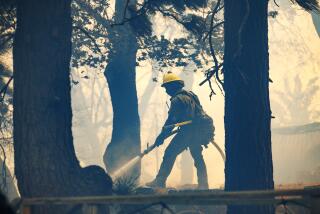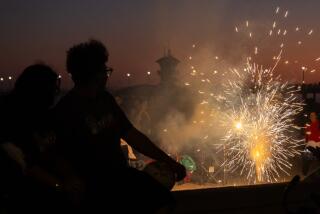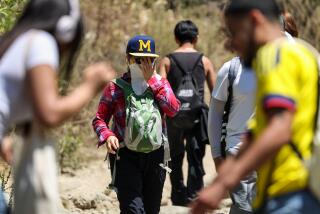Fireworks This 4th Are Put Out by Fears
The old railroad town of Como, Colo., usually celebrates the Fourth of July with a bang: 30 minutes of elaborate fireworks, screeching, high-flying shells and cascading showers of red, white and blue stars that attract hundreds from nearby communities.
This year, not only in Como but across the scorched and burning West, authorities are canceling fireworks displays, fearing that an errant spark could lead to catastrophe.
“Our town is more important than fireworks,” said Stan Miller, president of the Como Civic Assn. “It’s not worth the risk.”
In post-Sept. 11 America, Independence Day will have special meaning, said Adrian Hise, chief fire marshal of Boulder, Colo. But fireworks aren’t the only way to express national pride.
“It’s a different world we’re living in this summer,” he said. “The drought is the way it is, and I think people are adjusting to that fact.”
Tinderbox conditions have led the governors of Wyoming, Colorado and Utah to ban fireworks on all state land, including parks and recreation areas.
“We are one Roman candle away from a nightmarish inferno,” said Utah Gov. Mike Leavitt as he announced a fireworks ban Wednesday on 4.1 million acres of public land.
State officials generally don’t have the power to prohibit fireworks in municipalities. But local authorities are quickly enacting their own bans. At least 35 of New Mexico’s 102 incorporated towns have imposed some kind of fireworks restriction. The New Mexico state forester predicted the danger as early as May, when he banned fireworks on 43 million acres of public land.
Still, competing laws make compliance difficult to enforce. In Arizona and seven other states, fireworks are illegal except when handled by a licensed pyrotechnic company. But people who drive across state lines can get their hands on a slew of sparklers, Black Cat firecrackers and smoke bombs, said Jim Wheeler, Flagstaff’s assistant fire chief.
“All they have to do is drive to one of our four neighboring states. Those are the people who start fires, and they are hard to monitor,” he said.
Wildfires are such a concern in Colorado that even fireworks shows over water have been called off. In the Rocky Mountain town of Frisco, the Independence Day display is one of the area’s most reliable draws, attracting 15,000 people every year. Although the shells explode over Lake Dillon and there is a 2,000-foot safety zone between the water and Arapahoe National Forest, the town canceled the party. “One little spark might blow into the forest, and you just don’t know what could happen,” said spokeswoman Linda Lichtendahl. “It’s a decision based on safety.”
The Flagstaff Fire Department had safety in mind when it organized a fireworks extravaganza. Its plan called for a launch site on a golf driving range bordered by five Little League baseball fields. “It’s all dirt with nothing combustible,” Wheeler said. “It’s 100% safe from a fire safety perspective.”
Still, residents flooded the department with calls, and the city canceled the show.
“When real large wildfires are breaking out, there’s an overpowering emotional reaction,” Wheeler said. “The decision to cancel wasn’t based on fire science, it was based on social science and the need to assure that our residents felt comfortable.”
Residents are less jittery in California, where Jim Souza, president of a Rialto pyrotechnic company, said only one of its 500 Fourth of July shows had been called off by a community fearful of dry conditions.
Towns that can afford it are turning to laser-light shows instead of fireworks. Seattle-based Laser Fantasy International has had so many calls, especially from Colorado, that it turned away business, said sales Vice President Rikki Rothenberg-Klein.
Helena, Mont.; Sonora, Calif.; and Boulder are among the towns paying $15,000 to $25,000 for a 30-minute spectacle of multicolored laser beams projecting images of flags, stars and eagles to the beat of patriotic music.
“It won’t be fireworks, but at least it’s safe,” said Hise, Boulder’s fire marshal.
The folks in Como, population 29, can’t afford a fire hydrant, much less a laser-light show. But when night falls on Independence Day, Stan Miller will pull out the lawn chairs as he always does. The American flag will hang from a pole in the frontyard. And he’ll settle back and watch the twinkling stars and the glowing beauty of the quarter moon.
“That’ll be a show in itself,” Miller said. “It’ll be a good Fourth of July.”
*
Times staff writer Christine Hanley in Orange County contributed to this report.
More to Read
Sign up for Essential California
The most important California stories and recommendations in your inbox every morning.
You may occasionally receive promotional content from the Los Angeles Times.










